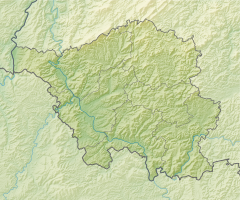Heinitz mine
| Heinitz mine | |||
|---|---|---|---|
| General information about the mine | |||
| Memorial for the Heinitz tunnel | |||
| Mining technology | Underground mining | ||
| Funding / year | > 1 million t | ||
| Information about the mining company | |||
| Operating company | 1814–1918 Kingdom of Prussia 1919–1935 Mines Domaniales Francaise de la Sarre 1935–1948 Saargruben AG 1948–1957 Director of the Mines de la Sarre from 1957 Saarbergwerke AG |
||
| Start of operation | 1851 | ||
| End of operation | 1962 | ||
| Successor use | Commercial establishments | ||
| Funded raw materials | |||
| Degradation of | Hard coal | ||
| Geographical location | |||
| Coordinates | 49 ° 19 '45.6 " N , 7 ° 8' 13.6" E | ||
|
|||
| Location | Center of the Heinitz district | ||
| local community | Neunkirchen (Saar) | ||
| District ( NUTS3 ) | Neunkirchen | ||
| country | State of Saarland | ||
| Country | Germany | ||
| District | Saar | ||
The Heinitz mine is a former coal mine in Heinitz near Neunkirchen (Saar) .
history
Already in the 7th century BC the Celts were mining coal for the production of jewelry and grave goods in the area of the pit . Extensive geological investigations were carried out from 1843. In 1847 Prussia began to mine coal in the mine with the attack on the Heinitz tunnel and made coking attempts .
From 1859 onwards, coal was mined in regular shifts. A small pit was created with a colliery and forge . The deaf rock and slag were stored in the Binseswiesental, where a counter location was also created. In the same year, the first coal train started in Saarland from the mine on the Neunkirchen – Neunkirchen-Heinitz railway line , which was built especially for this purpose. From 1851 the mine was run as an independent operation. The mine was named in honor of the Prussian Minister of State and head of the mining and smelting department Friedrich Anton von Heynitz .
1852, a second was Schacht set and a coal washing plant built. In the Colonie Elversberg (today: Spiesen-Elversberg ) a sleeping house was built for the miners . In the following years the pit grew steadily. The Dechen shafts were added, further sleeping houses were built and the first miners' houses were built. From 1860 onwards the industrial mining of coal began. In 1882 the mine reached an annual output of more than one million tons of hard coal. In 1890 the Heinitz mine was one of the first to have a gas engine to generate electricity for lighting. At the turn of the century, the mine was the largest Saar mine. In the meantime, in addition to the four Heinitz shafts and the three Dechener shafts, there were also the Geisheck I and II shafts, the wayside shrine shaft and the Mosel shaft. In 1911 the oak shaft and the Marsaut shaft were added.
In 1904/1905 a gas machine hall was built to produce electricity from coke oven gas . In 1906, the Heinitz gas machine hall took over supplying the mining operations. The community of Neunkirchen also obtained its electricity from the Heinitz mine. Over 6100 people now worked in the mine. Between 1936 and 1939, the Heinitz and Dechen daytime facilities were modernized.
The Heinitz mine was closed in 1962, followed by the Dechen mine in 1968. The coal reserves were allocated to the Reden mine .
architecture
The first gallery of the pit itself has been preserved in a small park .
A gas machine center that produced electricity from coke oven gas has also been preserved. The hall was built in 1904 and 1905 using a steel frame construction in Art Nouveau style. It has been a listed building since 1992.
The former administration building of the coking plant , the former benzene factory and a former laboratory building from 1920/21 have been preserved.
literature
- Delf Slotta The Saarland hard coal mining publisher Krüger Druck und Verlag GmbH & Co. KG (Dillingen / Saar 2011), publisher: RAG Aktiengesellschaft (Herne) and Institute for Regional Studies in Saarland eV (Schiffweiler), ISBN 978-3-00-035206-5
- Literature on Grube Heinitz in the Saarland Bibliography
Web links
- Information on the Heinitz mine from the Gasmaschinenzentrale initiative
- Extensive information and pictures about the Heinitz mine
Individual evidence
- ↑ a b c The history of the Heinitz mine , Initiative Gasmaschinenzentrale eV
- ↑ Brief description of Heinitz
- ↑ The Heinitz and Dechen pits , Delf Slotta
- ^ The Saarland coal mines
- ^ The gas machine center in Heinitz , es Heftche, city magazine for Neunkirchen and the surrounding area



